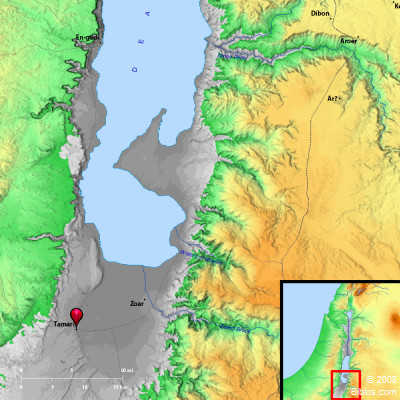Atlas  Tamar 2 (Tamar) and surrounding region
Maps Created using Biblemapper 3.0Additional data from OpenBible.infoOccurrences Ezekiel 47:18 The east side, between Hauran and Damascus and Gilead, and the land of Israel, shall be the Jordan; from the north border to the east sea you shall measure. This is the east side. Ezekiel 47:19 The south side southward shall be from Tamar as far as the waters of Meriboth Kadesh, to the brook of Egypt, to the great sea. This is the south side southward. Ezekiel 48:28 By the border of Gad, at the south side southward, the border shall be even from Tamar to the waters of Meribath Kadesh, to the brook of Egypt, to the great sea. Encyclopedia TAMAR (2)(tamar, "palm tree"; Thaiman):
(1) This name occurs in Ezekiel's ideal delimitation of the territory to be occupied by Israel (Ezekiel 47:19; Ezekiel 48:28). The Dead Sea is the eastern border; and the southern boundary runs from Tamar as far as the waters of Meriboth-kadesh to the Brook of Egypt and the Great Sea. The place therefore lay somewhere to the Southwest of the Dead Sea. "Hazazon-tamar (the same is En-gedi)" (2 Chronicles 20:2) is of course out of the question, being much too far to the North. Eusebius (in Onomasticon) mentions Asasonthamar, with which Thamara was identified. This place was a village with fortress and Roman garrison, a day's journey from Mampsis on the way from Hebron to Elath. It is the Thamaro mentioned by Ptolemy (v.16, 8), as a military station on the road from Hebron to Petra. It is named also in the Peutinger Tables. Neither Mampsis nor Thamaro has been identified.
(2) Among the towns "built" or fortified by Solomon, named in 1 Kings 9:18, is Tamar (the Revised Version (British and American) following Kethibh), or Tadmor (the King James Version following Qere; compare 2 Chronicles 8:4). Gezer, Beth-horon and Baalath, named along with it, are all in Southern Palestine, while Tamar is described as in the wilderness in the land, pointing to the Negeb or to the Wilderness of Judah. It was probably intended to protect the road for trade from Ezion-geber to Jerusalem. We may with some confidence identify it with (1) above. It is interesting to note that the Chronicler (2 Chronicles 8:4) takes it out of connection with the other cities (2 Chronicles 8:5), and brings its building into relation with Solomon's conquest of Hamath-zobah. Clearly in his mind it denoted the great and beautiful city of Palmyra, which has so long been known as "Tadmor in the Wilderness."
W. Ewing |
    |




